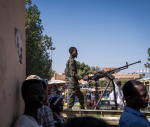You are here
Insights on Gaza from Madaba’s mosaic map
Mar 27,2024 - Last updated at Mar 27,2024
On the unique mosaic map decorating the floors of St. Georgios Church in Madaba, Gaza is shown with striking details, a proof that the city was the second largest after Jerusalem, reflecting a pivotal era in the history of Christianity.
Having spent much of my childhood in Madaba, I have seen the mosaic map countless times, and heard the familiar tales of its historical significance. Yet, it was not until recently that I realised that this remarkable artifact which visually documents the Christian era, has a lot to tell about Gaza during that time.
The inclusion of Gaza on the mosaic map triggered my curiosity, which was satisfied through reading from the Gaza Department of Antiquities, and a research paper titled Christian Topography of Byzantine Gaza, written by Moain Sadeq in the International Journal of Humanities and Social Science.
Situated at the crossroads between Canaan in Asia and Egypt in Africa, Gaza’s geostrategic significance made it acquire an extraordinary importance on all levels throughout history. By the end of the third century AD, Christianity started to expand in Gaza and the villages surrounding it, placing it as a focal point within the Christian world, and assuming a crucial role as a primary hub for pilgrimages between the holy sites of Palestine and the expansive Sinai Peninsula.
As a sign of its importance, a Cathedral was built in 407 AD, headed by Bishop Porphyry. Ruins of the church were uncovered inside the Omari Mosque.
Extensive archaeological excavations unveiled discoveries ranging from churches to exquisitely crafted mosaic pavements, showing the dominance of Christianity in Gaza and its neighbouring villages during the Byzantine period.
The mosaic map, dated into the Christian period during the reign of Justinian (527-565 AD) shows the entire city of Gaza, including churches, the main colonnaded streets intersecting in the centre of the city, city gates and wall, a huge platform that served as the remains of water clock marking the hours both by a bell and by moving bronze figures. Also, it shows the theatre depicted by a massive semi-circular structure in the south-eastern corner of the city, and the villages surrounding the city of Gaza mainly Beit Lahya and an-Nazla.
It’s important to acknowledge the rich historical roots of Christianity in Gaza and Palestine, tracing back to Saint Hilarion, a native of Gaza born in Thabatha in 291 AD.
Byzantium Gaza now is located under the entire territories of Gaza Strip. Due to the intensive population, archaeologists can only identify the exact locations of most Byzantine villages, describe their massive buildings, techniques, decoration and mosaic pavement inscriptions.
Fast forward, as the world bears witness to the relentless killing of innocent people, and the destruction of Gaza’s infrastructure, including its rich historical treasures, it becomes apparent that urgent action is needed. The people of Gaza are not merely statistics; they are human beings enduring unimaginable suffering. Now is the time to cease the madness of war, and to extend a helping hand to rebuild the shattered strip. Only then can we begin to talk about establishing lasting peace in the region.













Add new comment